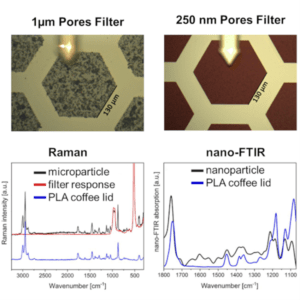Delegated Commission Decision of 11. 3. 2024 supplements Directive (EU) 2020/2184 of the European Parliament and of the Council and establishes a methodology for measuring microplastics in water intended for human consumption. This decision clearly defines the procedures for drinking water sampling and analytical methods, which include molecular (Raman and FTIR) microscopy.
Microplastics are small particles or fibers of polymeric materials, such as polystyrene, polypropylene, polyamide or polyethylene terephthalate, smaller than 5 mm in size. The normative analytical procedure for drinking water sets the lower limit for detection of microplastics at 20 micrometers. This value corresponds to the approximate diffraction limit of modern infrared microscopes (FTIR), which is determined by the physical properties of infrared radiation.
However, from a health protection perspective, this limit is insufficient. Smaller particles, called sub-micron and nanoparticles (nanoplastics) can be much more dangerous than larger objects because their ability to penetrate the human body is directly affected by their size and shape. For example, one recent scientific study showed that tea bags made of polypropylene, nylon 6 or cellulose release billions of particles measuring 140–250 nanometers, which is below the resolution of conventional analytical techniques.
FTIR or Raman microscopy is typically used to monitor microplastics in drinking water. Water samples are filtered through special filters made of various materials, such as silicon, silver, gold or alumina, which have precisely defined pore dimensions and shapes. Microplastics captured on the filters are then automatically detected, identified, quantified and reported using software algorithms. For example, the new Nicolet RaptIR+ FTIR microscope is ideal for this type of automated analysis.
However, if there is a need to analyze sub-micron particles, it is necessary to replace classical FTIR microscopy with the IR-SNOM technique. This method, which combines infrared spectroscopy with atomic force microscopy (AFM), allows for the measurement of near-field IR/FTIR spectra. For the identification of particles smaller than 0.5 micrometers, we offer a solution in the form of (FT)-IR SNOM technology from Attocube. With this technology, the spatial resolution of detection depends on the size of the AFM tip and reaches up to 10 nanometers.
Special silicon filters are now available for the analysis of nanoplastics. These filters, created using advanced lithography and etching techniques, have hexagonally arranged pores measuring 250 nm and 1 µm, which allows for the gradual filtration of water (for example, seawater). Their innovative design ensures high stability and compatibility with advanced analytical methods such as nano-FTIR for nanoparticle analysis and Raman spectroscopy for larger particles.

References:
- Commission Delegated Decision (EU) 2024/1441 of 11th of March 2024 supplementing Directive (EU) 2020/2184 of the European Parliament and of the Council by establishing a methodology for the measurement of microplastics in water intended for human consumption (notified under document C(2024)1459)
- Teabag-derived micro/nanoplastics (true-to-life MNPLs) as a surrogate for real-life exposure scenarios, Chemosphere, Volume 368, November 2024, 143736
- Multi-feature round silicon membrane filters enable fractionation and analysis of small micro- and nanoplastics with Raman spectroscopy and nano-FTIR, Anal. Methods, 2023,15, 606-617
